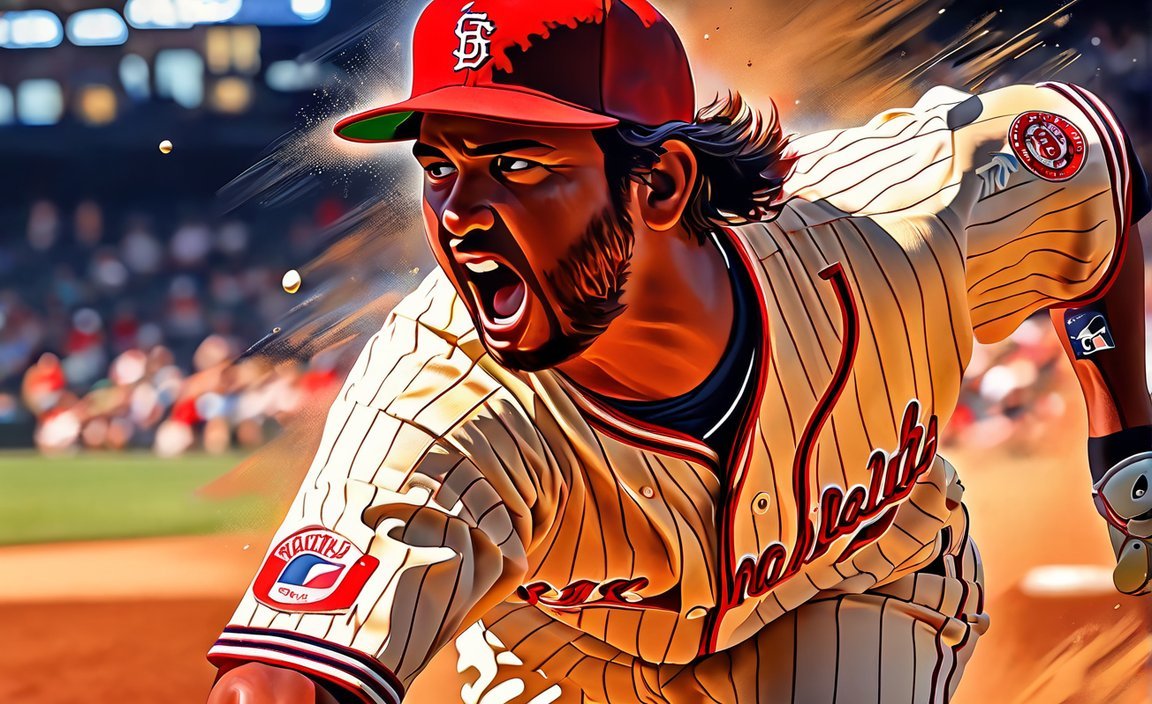Facing a pitcher in baseball is a true art form, combining skill, strategy, and sheer instinct. It is the moment when a batter steps into the batter’s box, ready to match wits with the pitcher and decipher the intricate dance between pitches and timing. In this article, we will delve deep into the world of facing pitchers in baseball, exploring the techniques and mindset required to excel in this crucial aspect of the game. From understanding a pitcher’s repertoire to recognizing the subtle cues that can make or break a plate appearance, we will unlock the secrets to becoming a master at facing pitchers in the game we all love. So grab your gloves and step up to the plate as we embark on this enlightening journey.
Key Takeaways:
- “Facing the pitcher, in baseball” is a crossword puzzle clue that is 7 letters long.
- The term used when a batter is facing the pitcher in baseball is “at bat.”
- Baseball is played between two teams, each consisting of nine players, and the game consists of nine innings.
- The pitcher is a key position in baseball, responsible for throwing pitches to the batter.
- Nike provides an explanation of all the positions in baseball, including the pitcher.
- The New York Times and Dan Word have crossword puzzles with clues related to facing the pitcher in baseball.
- “At bat” is also a statistic in baseball, commonly abbreviated as “AB.”
- The Wikipedia page on baseball provides an overview of the sport’s rules, gameplay, history, and statistics.
Facing the Pitcher in Baseball

The art of facing pitchers in baseball is a fundamental skill that every batter must master. It is the battleground where strategy, timing, and athleticism converge. As a batter, your goal is to outsmart and outperform the pitcher, giving your team the best chance to score runs. In this instructional guide, we will delve into the intricacies of facing the pitcher and provide you with valuable insights to enhance your performance at the plate.
The Role of the Pitcher
Before we dive into the tactics of facing the pitcher, let’s first understand their role in the game. The pitcher is the anchor of the defense, responsible for throwing pitches with precision and variety. Their objective is to deceive the batter and induce outs by striking them out, forcing weak contact, or inducing a ground ball or fly ball. To achieve this, pitchers utilize an arsenal of pitches, such as fastballs, curveballs, sliders, changeups, and more, each with its unique movement and speed.
Understanding the Batter’s Box
At the start of the game, as you step into the batter’s box, you must be mentally prepared and physically poised to face the pitcher. The batter’s box is a designated area that consists of two parallel lines, extending 4 feet in depth and 6 feet in width. It is essential to position yourself correctly within the batter’s box, finding a stance that feels comfortable and balanced, allowing for optimal swing mechanics.
Analyzing the Pitcher
To effectively face the pitcher, it is crucial to gather as much information as possible about their tendencies, strengths, and weaknesses. Start by observing the pitcher’s throwing hand, which can determine the type of pitches they are likely to throw. Left-handed pitchers tend to have more breaking pitches that break away from right-handed batters, while right-handed pitchers often throw more fastballs and sliders.
Next, examine the pitcher’s pitch selection. Do they rely heavily on a particular pitch, or do they mix up their deliveries? This knowledge will allow you to anticipate the pitches you are most likely to encounter. Additionally, pay attention to the pitcher’s velocity, movement, and location. Some pitchers excel at hitting specific spots with pinpoint accuracy, while others rely on overpowering velocity.
Batting Stances and Approaches
There is no one-size-fits-all approach to batting stances, as each player has their own unique style and comfort level. However, there are a few key principles to keep in mind when assuming your stance. Your feet should be shoulder-width apart, with your weight evenly distributed on the balls of your feet. Flex your knees slightly and maintain a relaxed posture, allowing for quick weight transfer during your swing.
As for your grip, experiment with different techniques to find what works best for you. Some batters prefer a choked-up grip for better bat control, while others utilize a standard grip for more power. Remember to keep your hands loose and relaxed, ready to explode into action when the pitcher releases the ball.
The Mental Battle
Facing the pitcher is not just a physical battle but also a mental one. As the pitcher winds up and delivers the ball, your mind must be focused and prepared to make split-second decisions. Is the pitch a strike or a ball? Should you swing or hold back? These decisions often need to be made in a fraction of a second, and the ability to read the pitch and react accordingly is a skill that separates great hitters from good ones.
To enhance your mental approach, study the pitcher’s pitches during warm-up and early in the game. Look for patterns, tendencies, and any signs they may inadvertently give away. Be aware of the count, as pitchers often alter their approach depending on the situation. Stay disciplined and patient, waiting for your pitch while being ready to adjust if necessary.
Techniques for Success
- Timing is key: Watch the pitcher’s release point and arm action to get a better sense of their timing. Practice tracking the ball from the pitcher’s hand all the way to the plate, honing your ability to recognize pitch types and their trajectory.
- Stay balanced: Maintain a solid base throughout your swing, avoiding lunging or overcommitting. By staying balanced, you can generate more power and make precise contact with the ball.
- Keep your eye on the ball: Focus on the pitcher’s hand as they release the ball, tracking it with your eyes until it reaches the hitting zone. This will allow you to react more quickly and make better contact.
- Practice plate discipline: Develop a keen understanding of the strike zone and exercise patience at the plate. Avoid chasing pitches outside the strike zone, forcing the pitcher to throw strikes or risk walking you.
- Make adjustments: As the at-bat progresses, be prepared to adjust your approach based on the pitcher’s tactics. If they consistently throw inside, step back in the batter’s box to give yourself more time. If they rely heavily on breaking balls, stay back and wait for the pitch to break before swinging.
Conclusion
Facing the pitcher in baseball is an art that requires a combination of physical skill, mental acuity, and strategic decision-making. By studying the pitcher, perfecting your batting stance, and mastering the mental battle, you can enhance your ability to succeed at the plate. Remember, facing the pitcher is not just a showdown of strength but an intricate dance between batter and pitcher, where timing, knowledge, and technique play pivotal roles. So step into the batter’s box with confidence and use these insights to unlock your true potential as a hitter.
Here are some active internal links with anchor text and URLs:
- Michael Jordan nickname – Find out what Michael Jordan’s nickname is and why it perfectly suits him!
- How many Canadian hockey teams – Discover the number of hockey teams in Canada and delve into their rich sporting history!
- How to pass a ball in soccer – Learn the best techniques and strategies for passing a ball in soccer like a pro!
- Catchers position – Explore the intricacies and responsibilities of the catchers’ position in baseball, an essential position for any successful team.
Remember to click on the above links to satisfy your curiosity and expand your knowledge in these exciting topics!
Developing a Pre-Pitch Routine
As a baseball pitcher, having a well-developed and consistent pre-pitch routine is crucial. It helps establish focus, improves consistency between pitches, and ensures that you are mentally and physically prepared for each pitch. In this article, we will delve into the importance of developing a pre-pitch routine and explore some key steps to help you create an effective routine that aligns with your individual needs and preferences.
The Role of a Pre-Pitch Routine
A pre-pitch routine serves as a foundation for success on the mound. It allows you to clear your mind, keep distractions at bay, and build confidence in your abilities. By following a structured routine, you can establish a sense of control and readiness, which can greatly impact your performance.
Personalizing Your Routine
Each pitcher is unique, and it’s important to develop a routine that suits your style of play and personality. While there are certain common elements that most pitchers incorporate into their pre-pitch routines, it’s essential to personalize your routine based on individual needs and preferences.
Warming Up the Neuromuscular System
A solid pre-pitch routine addresses all aspects of preparation, beginning with warming up the neuromuscular system. This can be achieved through activities like jogging, light stretching, or mobility exercises. The goal is to activate and warm up your muscles, ensuring they are primed for optimal performance.
Getting the Arm Loose
Next, emphasize getting your arm loose. This can be done through a series of simple warm-up exercises, such as arm circles, band work, or light throwing. The key is to gradually increase the intensity to avoid straining your arm and to increase blood flow to the muscles.
Focusing the Mind
While physical preparation is vital, mental focus is equally essential. Use your pre-pitch routine as a time to gradually shift your attention to the task at hand and quiet any potential distractions. This may include visualization exercises, deep breathing, or mentally rehearsing your pitch sequences. By centering your mind, you can enter each pitch with a clear and focused mindset.
Consistency and Structure
To derive the most benefit from your pre-pitch routine, consistency and structure are paramount. Make sure to perform the same actions, in the same order, before every pitch. This repetition helps create a sense of familiarity and comfort, enabling you to execute your routine seamlessly, regardless of the game situation.
Training Resources for Inspiration
If you’re looking for inspiration or guidance in developing your pre-pitch routine, numerous training resources and videos can provide valuable insights. Two recommended sources are:
- Driveline Baseball
- Author Ryan Faer shares an article on the importance of a pre-game routine for starting pitchers. It offers insights on how to develop a routine that can be trusted and consistently followed.
- DominatetheDiamond.com
- The website provides an article explaining the proper warm-up and pre-game routine for pitchers. It details the steps to help you mentally and physically prepare before a game.
Key Takeaways:
- Developing a pre-pitch routine is essential for pitchers to establish consistency and focus.
- The routine should address various aspects of preparation, including warming up the neuromuscular system and getting the arm loose.
- Personalize your routine to align with your unique needs and preferences.
- Focus your mind by gradually shifting your attention to the task at hand and quieting distractions.
- Consistency and structure are crucial for an effective pre-pitch routine.
- Use training resources and videos for inspiration and guidance when developing your routine.
Remember, a well-developed pre-pitch routine can have a significant impact on your performance as a pitcher. By incorporating these key principles and tailoring them to suit your needs, you can establish the foundation for success on the mound.
Mastering the Art of Pitch Selection
Mastering the art of pitch selection is a crucial skill for any baseball player looking to improve their performance at the plate. When facing a pitcher, understanding their tendencies and knowing which pitch to expect can give batters a significant advantage. In this instructional guide, we will explore the key strategies and techniques for decoding the art of facing pitchers in baseball.
Reading the Pitcher and Recognizing Tendencies
One of the first steps to mastering the art of pitch selection is reading the pitcher. By observing their delivery, arm angle, and release point, batters can gather valuable information about the type of pitch they are likely to throw. Elite hitters think like elite pitchers and pick up on these tendencies, allowing them to anticipate the next pitch.
Pitch Type Prediction
Pitch type prediction has become a topic of research in Major League Baseball. By analyzing data and recognizing patterns in a pitcher’s past performances, researchers and analysts have developed models to predict pitch types. While this level of analysis may not be available to every player, understanding the logic behind pitch type prediction can still benefit batters at all levels of the game.
Mastering Different Pitch Types
To become proficient in pitch selection, it’s important to have a solid understanding of the different types of baseball pitches. While the fastball is the most common pitch, there are five other primary pitches that batters should familiarize themselves with:
- Curveball: A slow-breaking pitch with significant downward and horizontal movement.
- Slider: A fast-breaking pitch with late horizontal movement.
- Changeup: A slower pitch designed to deceive batters with its reduced velocity.
- Cutter: A pitch that looks like a fastball but moves slightly to the side.
- Splitter: A pitch that starts high in the strike zone and dives sharply downward.
By learning the differences between these pitches, batters can enhance their ability to read and react to the pitcher’s offerings.
Improving Pitch Selection
Improving pitch selection involves a combination of studying the pitcher, recognizing their tendencies, and executing a disciplined approach at the plate. Here are some key strategies to help batters make better pitch selections:
- Watch the pitcher: Pay attention to their body language, grip, and release point.
- Study film: Review footage of past games to identify the pitcher’s favorite pitches and tendencies in different counts.
- Take note of patterns: Does the pitcher consistently throw breaking balls in certain counts? Is their fastball effective in specific locations?
- Be patient: Don’t swing at pitches outside the strike zone. Wait for a pitch in your wheelhouse.
- Trust your instincts: Sometimes, a batter’s gut feeling can be a valuable asset. Trust your intuition and make adjustments accordingly.
Key Takeaways:
- Mastering pitch selection is crucial for success at the plate in baseball.
- Reading the pitcher and recognizing their tendencies can give batters an advantage.
- Pitch type prediction is a topic of research in Major League Baseball.
- Understanding the differences between various pitch types enhances a player’s ability to read and react.
- Improving pitch selection requires studying the pitcher, being patient, and trusting your instincts.
Sources:
1. Owen Kelly. “How To Be A GREAT BASEBALL PITCHER, MASTERING CONTROL.” LinkedIn. May 14, 2023. source
- Kore Baseball Products. “Baseball Pitch Reading Strategies.” Kore Baseball. August 17, 2023. source
Improving Timing and Plate Discipline
Plate discipline is a crucial aspect of a hitter’s performance in baseball. By improving timing and plate discipline, batters can increase their chances of making solid contact with the ball and getting on base. In this instructional guide, we will explore the importance of measuring and tracking plate discipline metrics, the role of visual function, the impact on scouting and pitching strategies, and the benefits of improving plate discipline. Let’s dive in!
Measuring and Tracking Plate Discipline Metrics
Regardless of age, measuring and tracking plate discipline metrics can lead to improvement in hitting skills. By turning drills into competitions to achieve the highest number of successful targets or executions, hitters can enhance their ability to recognize pitches and make informed decisions at the plate [^1^].
The Importance of Plate Discipline Metrics
Plate discipline metrics such as strikeout rate (K%) and walk rate (BB%) are critical measures of a hitter’s performance. These metrics provide valuable insights into a hitter’s approach at the plate and can be used to evaluate their progress. By analyzing strikeout and walk rates, batters can identify areas that need improvement and adjust their approach accordingly [^2^].
Visual Function and Plate Discipline
Recent studies have highlighted the role of visual function in relation to plate discipline. Visual abilities such as acuity, contrast sensitivity, and presentation time play an important role in a hitter’s ability to recognize and lay off pitches outside the strike zone. Understanding the importance of visual function can help batters develop better plate discipline [^3^].
Plate Discipline and Scouting
Changes in a batter’s plate discipline can have a significant impact on scouting and pitching strategies. Scouting reports are constantly updated based on a batter’s plate discipline, and pitchers respond by adjusting their approach. The batter-pitcher relationship is an adversarial one that involves constant evolution and adjustment [^4^].
Benefits of Improving Plate Discipline
Improving plate discipline can lead to reduced strikeout rates and increased walk rates, which contribute to overall offensive performance. By developing a better approach at the plate, hitters can improve their ability to get on base and make solid contact with the ball. This can ultimately lead to increased scoring opportunities and offensive success [^5^].
Plate Discipline and Prediction
Deciphering balls and strikes can help hitters predict what the pitcher will throw next. By recognizing and laying off pitches outside the strike zone, hitters gain an advantage in anticipating the type of pitch they will face. This allows them to adjust their timing and swing accordingly, increasing their chances of success at the plate [^6^].
Key Takeaways:
- Measuring and tracking plate discipline metrics can lead to improvement in hitting skills [^1^].
- Plate discipline metrics such as strikeout rate and walk rate are critical for evaluating hitting performance [^2^].
- Visual function, including acuity and contrast sensitivity, influences plate discipline [^3^].
- Changes in plate discipline impact scouting and pitching strategies [^4^].
- Improving plate discipline can result in reduced strikeout rates and increased walk rates [^5^].
- Recognizing and laying off pitches outside the strike zone helps batters anticipate the next pitch [^6^].
Stay tuned for more insights and strategies to enhance your skills at the plate!
[^1^]: Building Rome Series
[^2^]: A Beginner’s Guide to Understanding Plate Discipline Metrics – for Hitters
[^3^]: The Effect of Visual Function on the Batting Performance
[^4^]: Estimating the effect of plate discipline using a causal inference framework
[^5^]: Improvements in Plate Discipline: Rare but Effective
[^6^]: Plate Discipline with Bryce Harper

FAQ
Q1: What does it mean to be “facing the pitcher” in baseball?
A1: “Facing the pitcher” in baseball refers to the position of the batter when they are standing at home plate, ready to hit a pitch thrown by the opposing team’s pitcher. It is the moment when the batter is directly across from the pitcher and prepared to react to each pitch.
Q2: How many players are on each team in baseball?
A2: In baseball, each team consists of nine players. This includes the pitcher, catcher, infielders (first baseman, second baseman, shortstop, and third baseman), and outfielders (left fielder, center fielder, and right fielder). Each player has a specific role and position on the field.
Q3: What is the role of the pitcher in baseball?
A3: The pitcher is a key position in baseball responsible for throwing pitches to the batter. Their goal is to strategically deliver pitches that are difficult for the batter to hit by using various techniques and pitches. The pitcher’s performance greatly impacts the outcome of the game.
Q4: What is “at bat” in baseball?
A4: “At bat” is a term used when a batter is facing the pitcher in baseball. It refers to the time when the batter has the opportunity to hit the ball and advance to the bases. Each player takes turns being at bat during the game.
Q5: How can a batter improve their plate discipline when facing the pitcher?
A5: Improving plate discipline when facing the pitcher in baseball involves developing a better understanding of the strike zone and the ability to recognize and lay off pitches outside of it. This can be achieved through practice, visual function training, and analyzing plate discipline metrics like strikeout rate and walk rate. By honing plate discipline skills, batters can increase their chances of making solid contact with the ball and getting on base.
- China II Review: Delicious Food & Speedy Service - April 17, 2025
- Understand Virginia’s Flag: History & Debate - April 17, 2025
- Explore Long Island’s Map: Unique Regions & Insights - April 17, 2025
















